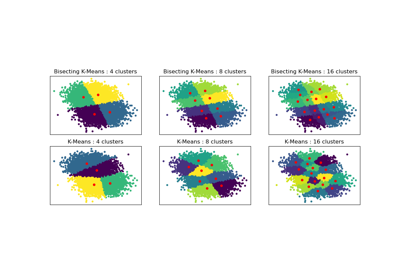Note
Go to the end to download the full example code or to run this example in your browser via JupyterLite or Binder.
An example of K-Means++ initialization#
An example to show the output of the sklearn.cluster.kmeans_plusplus
function for generating initial seeds for clustering.
K-Means++ is used as the default initialization for K-means.

# Authors: The scikit-learn developers
# SPDX-License-Identifier: BSD-3-Clause
import matplotlib.pyplot as plt
from sklearn.cluster import kmeans_plusplus
from sklearn.datasets import make_blobs
# Generate sample data
n_samples = 4000
n_components = 4
X, y_true = make_blobs(
n_samples=n_samples, centers=n_components, cluster_std=0.60, random_state=0
)
X = X[:, ::-1]
# Calculate seeds from k-means++
centers_init, indices = kmeans_plusplus(X, n_clusters=4, random_state=0)
# Plot init seeds along side sample data
plt.figure(1)
colors = ["#4EACC5", "#FF9C34", "#4E9A06", "m"]
for k, col in enumerate(colors):
cluster_data = y_true == k
plt.scatter(X[cluster_data, 0], X[cluster_data, 1], c=col, marker=".", s=10)
plt.scatter(centers_init[:, 0], centers_init[:, 1], c="b", s=50)
plt.title("K-Means++ Initialization")
plt.xticks([])
plt.yticks([])
plt.show()
Total running time of the script: (0 minutes 0.048 seconds)
Related examples

Bisecting K-Means and Regular K-Means Performance Comparison
Bisecting K-Means and Regular K-Means Performance Comparison

A demo of K-Means clustering on the handwritten digits data
A demo of K-Means clustering on the handwritten digits data

Comparison of the K-Means and MiniBatchKMeans clustering algorithms
Comparison of the K-Means and MiniBatchKMeans clustering algorithms
